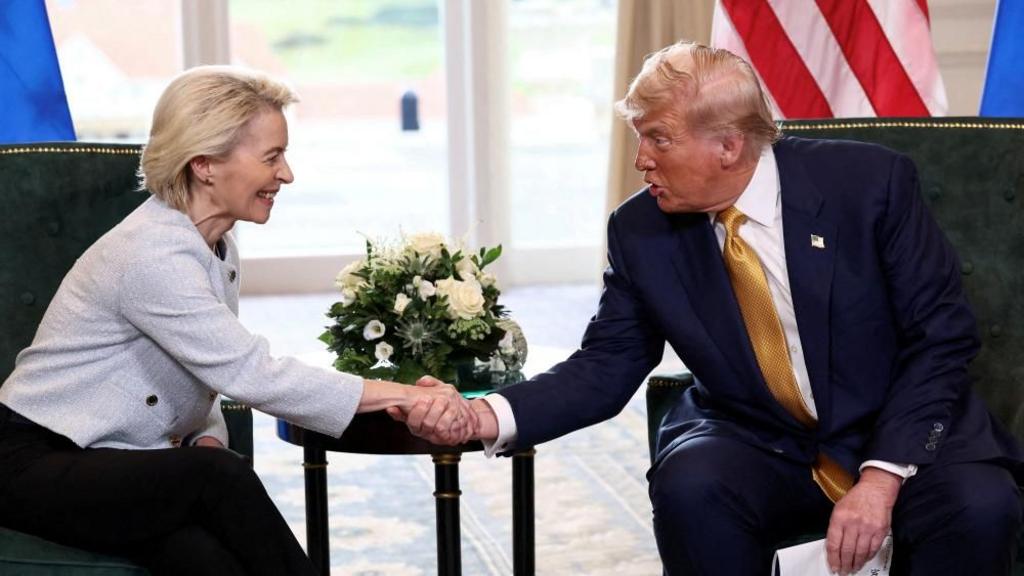Former US President Donald Trump has scaled back plans to impose substantial tariffs on pharmaceuticals and semiconductors imported from the European Union.
Last month, Trump indicated that pharmaceuticals and semiconductors were not included in the US-EU trade agreement, suggesting potential tariff rates of 250% and 100% on those sectors, respectively.
However, newly disclosed details of the US-EU agreement on Thursday reveal that tariffs on EU pharmaceuticals and semiconductors will be capped at 15%, aligning with the majority of sectors covered by the trade deal.
As a prerequisite, the EU must first enact legislation eliminating US export tariffs to unlock a reduction in tariffs on car exports from 27.5% to 15%.
In a joint statement regarding the agreement, the US and EU characterized it as an “initial step” with potential for expansion as the relationship evolves.
The trade deal was initially unveiled during a meeting between Trump and European Commission President Ursula von der Leyen in Scotland the previous month.
They concurred to lower tariffs on most EU exports to 15%, a figure halfway between Trump’s original threat and the 10% tariff secured by the UK.
At the time, von der Leyen portrayed it as a “framework” agreement, with further details to be resolved in the ensuing weeks.
Subsequent threats of higher tariffs on pharmaceutical and semiconductor exports to the US, however, fueled concerns that these products might be excluded from the accord.
In July, Trump had floated the idea of raising pharmaceutical tariffs to 200%, and during an August 5 appearance on CNBC, he suggested they could eventually reach as high as 250%.
“We want pharmaceuticals made in our country,” he told CNBC.
Ireland, an EU member state, is a significant pharmaceutical exporter to the US, as are other European nations. Novo Nordisk, the manufacturer of Ozempic, is also headquartered in Europe, specifically in Denmark.
On Thursday, Ireland’s Deputy Prime Minister and Foreign Minister, Simon Harris, expressed satisfaction with the assurance that the 15% rate would encompass pharmaceuticals and semiconductors.
“This offers crucial protection to Irish exporters who might otherwise have faced much steeper tariffs,” he stated. “Our focus now is to identify additional carve-outs in areas of interest to Irish exporters.”
According to the joint agreement, the US will implement the new 15% tariff rate on the majority of European goods, including European semiconductor and lumber exports, starting September 1.
In exchange, the EU will eliminate tariffs on “all US industrial goods,” including agricultural products such as fresh fruits and vegetables, pork, bison meat, and tree nuts.
The White House will reduce the 27.5% tariff on European motor vehicle exports to 15% only after Europe removes tariffs on US exports, a step that requires legislative action, according to the agreement.
EU Trade Commissioner Maros Sefcovic announced at a news conference that the deal stipulates the 15% tariff on cars will be retroactively applied from the beginning of the month in which the legislative process commences.
Sefcovic expressed the EU’s “firm intention” to initiate that process this month and noted that he had received assurances from the US that the lower tariff would then be applied from August 1.
EU Commission President Ursula von der Leyen stated that the deal provides predictability for the bloc’s businesses and consumers, as well as “stability in the largest trading partnership in the world.”
“This EU-US trade deal delivers for our citizens & companies, and strengthens transatlantic relations,” she posted on X on Thursday.
US Secretary of Commerce Howard Lutnick asserted that the deal “creates historic access to the vast European markets” for American producers.
“The America First Trade Agenda has secured the most important trading partner creating a major win for American workers, US. industries, and our national security,” he wrote on X.
“Tariffs should be one of America’s favorite words.”
The agreement follows months of tariff threats and intense negotiations between the US and the EU, after Trump initially announced in April that he would impose a 30% tariff on all European exports.
However, disappointment was expressed on both sides of the Atlantic regarding the exclusion of wine and spirits from tariff exemptions.
The French wine exporters federation, FEVS, stated that this would “create major difficulties for the wines and spirits sector.”
Mr. Sefcovic acknowledged that with wine and spirits, “unfortunately, here we didn’t succeed,” but added, “these doors are not closed forever.”
In the US, the Distilled Spirits Council also voiced disappointment with the agreement.
It argued that without “a permanent return to zero-for-zero tariffs on spirits,” US distillers would lack the certainty needed for future growth planning, while higher tariffs on EU spirits would “further compound the challenges facing restaurants and bars” in the US.
In its 323-page ruling, the New York judges stated that the fine was excessive, and likely violated the US Constitution.
Dobson was considered a key spokesperson for conservative causes in US politics over several decades.
US authorities have linked Wale’s car to an alleged criminal enterprise operating stateside.
The firings are part of mass layoffs announced by Health Secretary Robert F Kennedy Jr in March.
No one was seriously injured after brake failure sent an earthmover careening through traffic, officials said.

